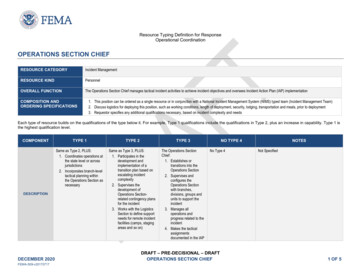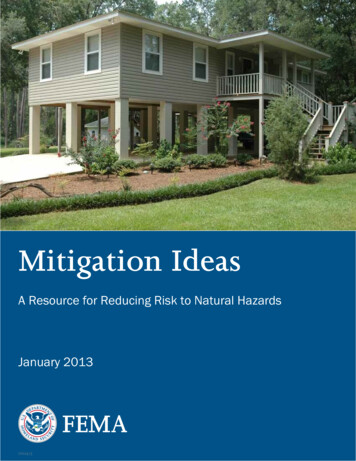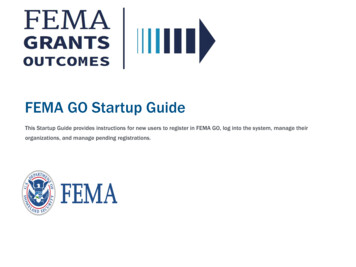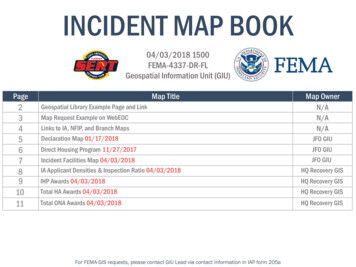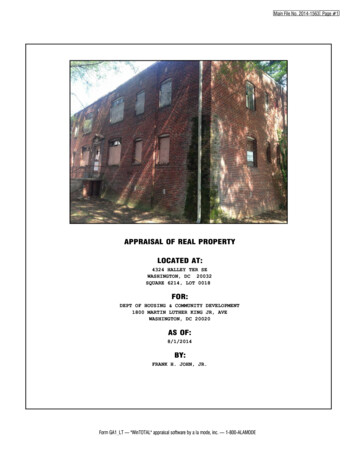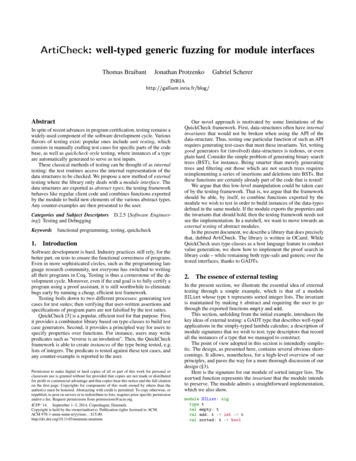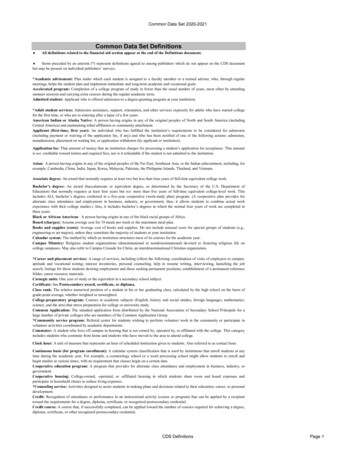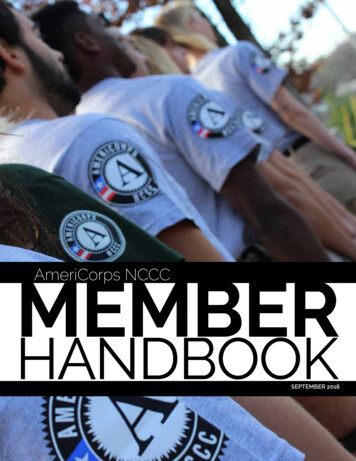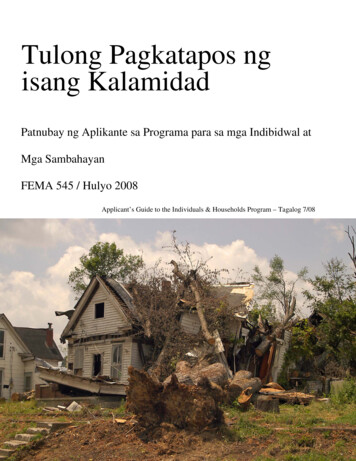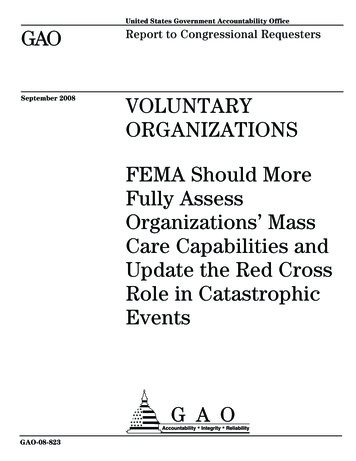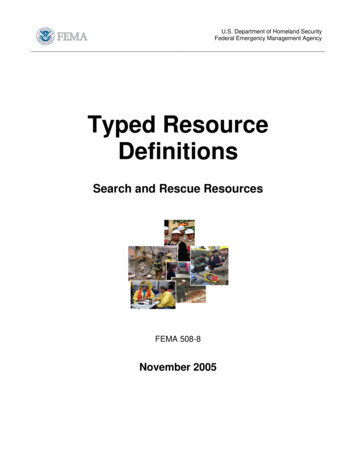
Transcription
U.S. Department of Homeland SecurityFederal Emergency Management AgencyTyped ResourceDefinitionsSearch and Rescue ResourcesFEMA 508-8November 2005
U.S. Department of Homeland SecurityFederal Emergency Management AgencyBackgroundThe National Mutual Aid and Resource Management Initiative supports the NationalIncident Management System (NIMS) by establishing a comprehensive, integratednational mutual aid and resource management system that provides the basis to type,order, and track all (Federal, State, and local) response assets.ResourceTypingFor ease of ordering and tracking, response assets need to be categorized viaresource typing. Resource typing is the categorization and description of resourcesthat are commonly exchanged in disasters via mutual aid, by capacity and/orcapability. Through resource typing, disciplines examine resources and identify thecapabilities of a resource’s components (i.e., personnel, equipment, training). Duringa disaster, an emergency manager knows what capability a resource needs to haveto respond efficiently and effectively. Resource typing definitions will help defineresource capabilities for ease of ordering and mobilization during a disaster. As aresult of the resource typing process, a resource’s capability is readily defined and anemergency manager is able to effectively and efficiently request and receiveresources through mutual aid during times of disaster.Web SiteFor more information, you can also refer to the National Mutual Aid and ResourceManagement Web site located at:http://www.fema.gov/nims/mutual aid.shtm.SupersedureThis document replaces Search and Rescue Resources, dated May 2005ChangesChanged the name of the Swiftwater/Flood Search and Dive Rescue Team toSwiftwater/Flood Search and Rescue Team. Also added a reference source to theComments section.FEMA 508-8 Typed Resource Definitions - Search and Rescue Resources11/14/2005Page 2 of 41
U.S. Department of Homeland SecurityFederal Emergency Management AgencyTable of ContentsBackground. 2Resource Typing . 2Web Site . 2Supersedure. 2Changes . 2Air Search Team (Fixed-Wing) .4Airborne Reconnaissance (Fixed-Wing).5Canine Search and Rescue Team – Avalanche Snow Air Scent .7Canine Search and Rescue Team – Disaster Response .8Canine Search and Rescue Team – Land Cadaver Air Scent .9Canine Search and Rescue Team – Water Air Scent .10Canine Search and Rescue Team – Wilderness Air Scent .11Canine Search and Rescue Team – Wilderness Tracking/Trailing .12Cave Search and Rescue Team .13Collapse Search and Rescue Teams .18Mine and Tunnel Search and Rescue Team .21Mountain Search and Rescue Team .24Radio Direction Finding Team .28Swiftwater/Flood Search and Rescue Team .30US&R Incident Support Team .33US&R Task Forces.36Wilderness Search and Rescue Team .39FEMA 508-8 Typed Resource Definitions - Search and Rescue Resources11/14/2005Page 3 of 41
U.S. Department of Homeland SecurityFederal Emergency Management AgencyRESOURCE:CATEGORY:Air Search Team (Fixed-Wing)Search & Rescue (ESF #9)MINIMUM CAPABILITIES:COMPONENTMETRICTYPE IKIND:TYPE IITeamTYPE IIITYPE IVVehicleFixed-WingAircraftSame as Type IIIFR Capable Fixed-WingObservation AircraftSame as Type IVFixed-Wing ObservationAircraftVehicleCapacity4-8 passengers with cargonot to exceed designspecification of aircraftSame as Type IIISame as Type IV2-4 passenger with cargo notto exceed designspecification of aircraftEquipmentFlight SuitSame as Type IISame as Type IIISame as Type IVAppropriate level of PPEEquipmentCommunicationsSame as Type II except:Same as Type IIISame as Type IV except:Standard FAA FM RadioVideo/ElectronicSame as Type III except:Same as Type III except:Capable of Airborne VideoTransmissionCapable of flying back videoor still imageryTraining &RatingsPilot – Commercial(instrument) or highercertificate and complete unitcertification programPilot – Private Pilot(instrument) or highercertificate and complete unitcertification programObserver – Complete unitcertification programObserver – Complete unitcertification programEquipmentAircrewsSatellite PhoneVHF RadiosElectronic Direction FindingCapableNoneSame as Type IVPilot – Private Pilot or highercertificate and complete unitcertification programObserver – Complete unitcertification programAircrewsCrewAvailabilityAircrew(s) available forextended operationsAircrew(s) available for8 to 14 days of operationsAircrew(s) available for3 to 7 days of operationsAircrew(s) available for atleast 2 days of entFull incident command staffcapable of managing allphases of air searchoperationsIncident staff capable ofmanaging air operationsbranchIncident staff capable ofsupporting independent flightreleaseUnit level flight release; Nosearch managementcapabilitiesCOMMENTS:OTHERAircrews can work a maximum of 12-hour shifts, depending on individual unit policies and procedures. Aircraft will be maintained in accordance with Federal AviationAdministration Regulations. Aircraft will be expected to operate out of established airfield with paved runways. Aircrews will indicate fueling and runway requirements for theaircraft provided. Crew availability does not require continuous availability of specific personnel, only that crews are available to those specifications.FEMA 508-8 Typed Resource Definitions - Search and Rescue Resources11/14/2005Page 4 of 41
U.S. Department of Homeland SecurityFederal Emergency Management AgencyRESOURCE:CATEGORY:Airborne Reconnaissance (Fixed-Wing)Search & Rescue (ESF #9)MINIMUM CAPABILITIES:COMPONENTMETRICTYPE IKIND:TYPE IITeamTYPE IIITYPE IVVehicleFixed-WingAircraftSame as Type IIIFR Capable Fixed-WingObservation AircraftSame as Type IVFixed-Wing ObservationAircraftVehicleCapacity4-8 passengers with cargonot to exceed designspecification of aircraftSame as Type IIISame as Type IV2-4 passengers with cargonot to exceed designspecification of aircraftEquipmentFlight SuitSame as Type IISame as Type IIISame as Type IVAppropriate level of PPEEquipmentCommunicationsSame as Type II except:Same as Type IIISame as Type IV except:Standard FAA FM RadioVideo/ElectronicCapable of flying back videoor still imageryEquipmentSatellite PhoneCapable of High ResolutionAirborne Video TransmissionDesired: FLIR or otherinfrared capabilitiesOTHERVHF RadiosSame as Type III except:Capable of Low resolutionAirborne Video TransmissionCapable of flying back videoor still imageryNoneSame as Type IVPilot – Private Pilot or highercertificate and complete unitcertification programDesired: FLIR or otherinfrared capabilitiesDesired: Capable ofsupporting HyperspectralImaging RequestsPersonnelTraining &RatingsPilot – Commercial(instrument) or highercertificate and complete unitcertification programPilot – Private Pilot(instrument) or highercertificate and complete unitcertification programObserver – Complete unitcertification programObserver – Complete unitcertification programObserver – Complete unitcertification programPersonnelCrewAvailabilityAircrew(s) available forextended operationsAircrew(s) available for8 to 14 days of operationsAircrew(s) available for 3 to7 days of operationsAircrew(s) available for atleast 2 days of entFull Incident Command staffcapable of managing allphases of air searchoperationsIncident staff capable ofmanaging air operationsbranchIncident staff capable ofsupporting independent flightreleaseUnit level flight release; noincident managementcapabilitiesFEMA 508-8 Typed Resource Definitions - Search and Rescue Resources11/14/2005Page 5 of 41
U.S. Department of Homeland SecurityFederal Emergency Management AgencyRESOURCE:CATEGORY:Airborne Reconnaissance (Fixed-Wing)Search & Rescue (ESF #9)MINIMUM CAPABILITIES:COMPONENTCOMMENTS:METRICTYPE IKIND:TYPE IITYPE IIITeamTYPE IVOTHERAircrews can work a maximum of 12-hour shifts, depending on individual unit policies and procedures. Aircraft will be maintained in accordance with Federal AviationAdministration Regulations. Aircraft will be expected to operate out of established airfield with paved runways. Aircrews will indicate fueling and runway requirements for theaircraft provided. Crew availability does not require continuous availability of specific personnel, only that crews are available to those specifications.FEMA 508-8 Typed Resource Definitions - Search and Rescue Resources11/14/2005Page 6 of 41
U.S. Department of Homeland SecurityFederal Emergency Management AgencyRESOURCE:CATEGORY:Canine Search and Rescue Team – Avalanche Snow Air ScentSearch & Rescue (ESF #9)MINIMUM CAPABILITIES:COMPONENTPersonnelTYPE IMETRICDog Team1 DogKIND:TYPE IITYPE IIITeamTYPE IVOTHERSame as Type I1 Handler1 Support PersonEquipmentSearchCapabilitiesCapable of self-sustainingand searching for 24 hours inextreme weather and terrainconditions through avalanchedebris fieldsCapable of self-sustainingand searching for 24 hours insnow-covered environmentsin extreme weatherconditions and moderateterrainPersonnelEquipmentPersonal snow travelequipment and gear toself-sustain for 24 hoursSame as Type IEquipped to include crosscountry skis or snow shoes,poles, probe poles, snowshovel, and avalanchebeaconPersonnelCOMMENTS:TrainingTraining, including avalanchesafety and winter survival,including building snow cave,First Aid for both human anddog, personal/ dog safety,and radio communicationsSame as Type INote: Many of these resources are capable of searching in a disaster environment, such as a wilderness team in outlying areas of a tornado zone, etc. It is critical that caninemanagement personnel, knowledgeable in multiuse of canine resources, are available to Incident Command. This will not necessarily be reflected in this document.FEMA 508-8 Typed Resource Definitions - Search and Rescue Resources11/14/2005Page 7 of 41
U.S. Department of Homeland SecurityFederal Emergency Management AgencyRESOURCE:CATEGORY:Canine Search and Rescue Team – Disaster ResponseSearch & Rescue (ESF #9)MINIMUM CAPABILITIES:COMPONENTPersonnelTYPE IMETRICDog TeamKIND:TeamTYPE IITYPE IIITYPE IVOTHER1 Dog1 Handler1 Support PersonPersonnelSearchCapabilitiesA disaster search canine thathas successfully completedthe DHS/FEMA DisasterSearch Canine ReadinessEvaluation for both Type IIand Capable of national andinternational responsesA disaster search canine thathas successfully completedthe DHS/FEMA DisasterSearch Canine ReadinessEvaluation for Type II only;Capable of national andinternational responsesA disaster search canine thathas successfully completedDisaster Search CanineReadiness Evaluationthrough an organizeddisaster task force – nonFEMA; Capable of nationaland international responsesA search canine with minimalexposure to disaster search;Capable of local/regionalresponse only; No task forceparticipationTeamKnowledgeandEquipmentAll requirements as set forthby DHS/FEMA NationalUS&R Response SystemAll requirements as set forthby DHS/FEMA NationalUS&R Response SystemAll requirements as set forthby organized task force foravailability fornational/internationalresponseAgility; Obedience; First AidHuman/Dog; HazMat;Disaster; EnvironmentExposure minimal; Initialresponder readiness throughlocal agencyCOMMENTS:Please note that many of these resources are capable of searching in a disaster environment, such as a wilderness team in outlying areas of a tornado zone, etc. It is critical thatcanine management personnel, knowledgeable in multiuse of canine resources, are available to Incident Command. This will not necessarily be reflected in this document.FEMA 508-8 Typed Resource Definitions - Search and Rescue Resources11/14/2005Page 8 of 41
U.S. Department of Homeland SecurityFederal Emergency Management AgencyRESOURCE:CATEGORY:Canine Search and Rescue Team – Land Cadaver Air ScentSearch & Rescue, OtherMINIMUM CAPABILITIES:COMPONENTPersonnelTYPE IMETRICDog Team1 DogKIND:TYPE IITeamTYPE IIITYPE IVOTHERSame as Type ISame as Type ISame as Type ISame as Type I1 Handler1 Support PersonTeamSearchCapabilitiesCapable of locating less than15 grams of human remainsduring disaster ops; Capableof self-sustaining for 24hoursCapable of locatingdeceased persons (greaterthan 15 grams) in disasterops; Capable of selfsustaining for 24 hoursCapable of locating less than15 grams of human remainsburied, hanging, groundlevel, or in vehicles,nondisasterCapable of locating less than15 grams of human remainsburied, hanging, groundlevel, nondisasterCapable of locatingdeceased persons (greaterthan 15 grams) buried,hanging, ground level,nondisasterTeamKnowledgeandEquipmentSame as Type IISame as Type III plus:Same as Type IVTraining and equipment forbiohazard environment,including OSHA guidelines,scene preservation,documentation, collection,chain of custody, and scenesecuritySame as Type IVDisaster ops training andcapabilitiesFirst Aid for both human anddog, personal/ dog safety,and radio communicationsCOMMENTS:FEMA 508-8 Typed Resource Definitions - Search and Rescue Resources11/14/2005Page 9 of 41
U.S. Department of Homeland SecurityFederal Emergency Management AgencyRESOURCE:CATEGORY:Canine Search and Rescue Team – Water Air ScentSearch & Rescue (ESF #9)MINIMUM CAPABILITIES:COMPONENTPersonnelTYPE IMETRICDog TeamKIND:TeamTYPE IITYPE IIICapable of working stillwaterenvironments; Trained andequipped to perform searchops on foot and from anytype of watercraftCapable of workingswiftwater and stillwater opsfrom shore onlyTYPE IVOTHER1 Dog1 Handler1 Support PersonTeamSearchCapabilitiesCapable of workingswiftwater/stillwaterenvironments; Trained andequipped to perform searchops on foot and from anytype of watercraftCapable of workingswiftwater ops from shoreonlyType V capable of workingstillwater ops from shore onlyType VI capable of workingsalt-water and very largefresh water environmentsfrom both boat and shoreType VII capable of workingsalt-water and very largefresh water environmentsfrom shore onlyTeamKnowledgeandEquipmentWater Helmet; Class V WaterVest; Throw RopeWater Helmet; Class III-VWater Vest; Throw RopeSwiftwater lifesaving skills;Knowledge of water rescueand boat operations; First Aidfor both human and dog;Personal/dog safetyStillwater lifesaving skills;Knowledge of water rescueoperations in stillwaterenvironment; First Aid forboth human and dog;Personal/dog safetyRadio communicationsSame as Type ISame as Type IType V same as Type IIType VI, VII same as Type IRadio communicationsequipmentCOMMENTS:Note: Many of these resources are capable of searching in a disaster environment, such as a wilderness team in outlying areas of a tornado zone, etc. It is critical that caninemanagement personnel, knowledgeable in multiuse of canine resources, are available to Incident Command. This will not necessarily be reflected in this document.FEMA 508-8 Typed Resource Definitions - Search and Rescue Resources11/14/2005Page 10 of 41
U.S. Department of Homeland SecurityFederal Emergency Management AgencyRESOURCE:CATEGORY:Canine Search and Rescue Team – Wilderness Air ScentSearch & Rescue (ESF #9)MINIMUM CAPABILITIES:COMPONENTMETRICKIND:TYPE ITYPE IITeamTYPE IIITYPE IVOTHERSingleResourceSearchCapabilitiesCapable of search and selfsustaining for 72 hours in allweather and low anglewilderness terrain or largerareas of 60 acresCapable of searching andself-sustaining for 48 hours inall weather and low anglewilderness terrain or largerareas of 60 acresCapable of searching highprobability local wildernessterrain for short durations(24 hours or less) or smallareas 40-60 acresCapable of searching highprobability local wildernessterrain for short durations(12 hours or less) or smallareas 40-60 acresHuman discriminating (scentsource necessary)SingleResourceSearchCapabilitiesCapable of searching andself-sustaining for 72 hours inall weather and low anglewilderness terrain or largerareas of 120 acresCapable of searching andself-sustaining for 48 hours inall weather and low anglewilderness terrain or largerareas of 120 acresCapable of searching highprobability local wildernessterrain for short durations(24 hours or less) or smallareas of 60-120 acresCapable of searching highprobability local wildernessterrain for short durations(12 hours or less) or smallareas of 40-60 acresNon-discriminating (locate allhuman indication in area)COMMENTS:There are significant differences in the training required for urban versus wilderness environments, both in air scent/area and trailing/tracking. Because of the vast differences,often a resource highly skilled in one environment may not function as well in the other environment because of a lack of continuous training in the environment. Teams may becross-trained in both environments, depending on the team training criteria.Note: Many of these resources are capable of searching in a disaster environment, such as a wilderness team in outlying areas of a tornado zone, etc. It is critical that caninemanagement personnel, knowledgeable in multiuse of canine resources, are available to Incident Command. This will not necessarily be reflected in this document.FEMA 508-8 Typed Resource Definitions - Search and Rescue Resources11/14/2005Page 11 of 41
U.S. Department of Homeland SecurityFederal Emergency Management AgencyRESOURCE:CATEGORY:Canine Search and Rescue Team – Wilderness Tracking/TrailingLaw Enforcement/Security, Search & Rescue (ESF #9)MINIMUM CAPABILITIES:COMPONENTPersonnelMETRICDog TeamTYPE ISame as Type IVTYPE IISame as Type IVKIND:TeamTYPE IIISame as Type IVTYPE IV1 DogOTHERSame as Type IV1 Handler1 Support ble of trailing inwilderness terrainCapable of trailing inwilderness terrainCapable of trailing inwilderness terrainCapable of trailing inwilderness terrainDiscriminating (scent sourcemust be available)Aged 24 hours; 1 mile orlonger; Heavy contaminationAged 4-12 hours; 1 mile orlonger; Heavy contaminationAged 1.5-4 hours; .5-1 mile;Heavy contaminationAged 0-1.5 hours; .25-.5mile; Heavy contaminationPersonally equipped for 24hours for dog/handlerSame as Type ISame as Type ISame as Type IN/ASame as Type ISame as Type ISame as Type IN/AFirst Aid for both human anddogRadio communicationsPersonnelKnowledgeWilderness survival skillsCapable of establishing andmaintaining direction of travelFirst Aid for both human anddogPersonal/ dog safetySkill in collection of scentarticlesCOMMENTS:As these dogs use scent articles, they are commonly referred to as trailing dogs. However, occasionally, a unit may refer to such dogs as tracking dogs. They do have thecapability of human discrimination between sources with the aid of a provided scent source. Care should be taken to determine if a tracking dog requires the use of an article ornot.Note: Many of these resources are capable of searching in a disaster environment, such as a wilderness team in outlying areas of a tornado zone, etc. It is critical that caninemanagement personnel, knowledgeable in multiuse of canine resources, are available to Incident Command. This will not necessarily be reflected in this document.FEMA 508-8 Typed Resource Definitions - Search and Rescue Resources11/14/2005Page 12 of 41
U.S. Department of Homeland SecurityFederal Emergency Management AgencyRESOURCE:CATEGORY:Cave Search and Rescue TeamSearch & Rescue (ESF #9)MINIMUM CaveTrainingTYPE ISame as Type IIIKIND:TYPE IISame as Type IIITeamTYPE IIISame as Type IV plusField team leaderMedical specialistField team membersBasic understanding of thecave environment, includingregional differences inambient cave temperature,normal hazards such as riskof flooding, hypothermia, andpotential changes in caveenvironment because ofseasonal variations andoutside weather;Same as Type II, plus:Same as Type III, plus:Same as Type IV, plus:Proficiency in cave andsurface search;Proficiency in verticalenvironments greater than100 feet in depth;Ability to carry additionalrescue-related equipment toand through the caveProficiency in high- andlow-angle technical rescuesand evacuations from dry,wet, and multidrop cavesAbility to safely traversemultidrop caves;Ability to rapidly ascend arope next to a litter during alitter raiseTYPE IVOTHERProficiency in crawling,climbing and moving overuneven surfaces andbreakdown areas covered inmud, sand, or water;Familiarity with chimneying,bridging, and other basicclimbing techniques used inmoving through caves;Ability to move comfortablyand efficiently in smallspaces;Ability to rappel and ascend66’ of static line usingstandard single ropetechniques;Proficiency in changing overfrom ascent to rappel andrappel to ascent;Ability to carry personalFEMA 508-8 Typed Resource Definitions - Search and Rescue Resources11/14/2005Page 13 of 41
U.S. Department of Homeland SecurityFederal Emergency Management AgencyRESOURCE:CATEGORY:Cave Search and Rescue TeamSearch & Rescue (ESF #9)MINIMUM CAPABILITIES:COMPONENTMETRICTYPE IKIND:TYPE IITeamTYPE IIITYPE IVOTHERequipment to and through thecave;Ability to identify fragile caveenvironments and takemeasures to protect them;Ability to maintain primarylight sourcesPersonnelPersonnelNavigationTrainingSame as Type IIBasicTrainingSame as Type III, plus:Same as Type IV, plus:Proficiency in back-countrynavigation and route findingwith a map and compass,use of GPS and UTMcoordinate systemKnowledge of commonsymbols present on cavemaps; Proficiency in readingcave maps; Ability to usetopographic maps to locatecavesSame as Type II, plus;Same as Type III, plus:Same as Type IV, plus:Ability to plan, organize, anddirect cave rescue andsearch missions using ICS;Ability to direct activitiesaccording to ICS;Capable of operating withinICS;Technical proficiency insingle person rope rescuetechniques;Proficiency in edge tendingfor the vertical environment;Experience with ICS UnifiedCommandProficiency in crack andcrevice rescue;Proficiency in creating loaddistributing and artificialanchors in-caveProficiency in preparing andrigging basket and flexiblelitters for haul and loweroperations;Proficiency in patientpackaging for extrication;Familiarity with the basictechniques for crack andcrevice rescue;Ability to improvise patientpackagingFamiliar with cave maps andtopographic mapsFamiliarity with basic cavesearch techniques;Familiarity with the NIIMSICS of incident management;Proficiency in establishingsimple anchors and fixinglines for personal rappelsand ascents;Awareness of thepsychological and physicalpatient considerations inrescue extrications of longduration;Proficiency in basic in-cavelitter movement techniques;Ability to assist in patientpackaging for extrication;Specialized training requiredFEMA 508-8 Typed Resource Definitions - Search and Rescue Resources11/14/2005Page 14 of 41
U.S. Department of Homeland SecurityFederal Emergency Management AgencyRESOURCE:CATEGORY:Cave Search and Rescue TeamSearch & Rescue (ESF #9)MINIMUM CAPABILITIES:COMPONENTMETRICTYPE IKIND:TYPE IITeamTYPE IIITYPE IVOTHERto safely and appropriatelyuse communication andtechnical rescue equipmentPersonnelTechnicalTrainingSame as Type II, plus:Same as Type III, plus:Same as Type IV, plus:Proficiency in the use,placement, and analysis ofmechanical anchors andanchor systems;Understanding of themechanical forces involved intechnical rescue systems;Proficiency in tying commonknots and knowledge of theirapplications and strengthefficiencies;Proficiency in use ofhighlines and guiding lines;Proficiency in the selectionand setup of rescue anchorsystems;Proficiency in theorganization and direction oftechnical cave rescuesearches and rescues;Proficiency at estimatingcomponent and system loadratios and assessing safetyfactors;For regions/caves withswiftwater:Ability to rig and operatesimple and compound 4:1,6:1, and 9:1 mechanicaladvantage systems;Proficiency in working in andaround moving waterunderground;Swiftwater/flatwatertechnicianFor regions/caves with badair:Proficiency in the use of a3-gas monitor (oxygen,hydrogen sulfide and carbonmonoxide) and ability tounderstand its outputPersonnelSurvivalTrainingSame as Type IIIProficiency in establishingsimple anchors for haul andlower systems;Ability to establish 2:1 and3:1 haul systems, fixed brakelowering systems, and belaysystems;Ability to serve as a memberof an evacuation team;Other skills or abilities asidentified by the team’soperations leaderFamiliarity with basic searchtechniques andnomenclature;Proficiency in rigging and useof counterbalance systems;Ability to maintain sceneintegrity in case of crime;Proficiency in technical litterevacuations and transportincluding litter raises andlowers on breakdown, infree-fall and other verticalenvironments, in narrow orwaterfall situations, and inmultidrop cavesProficiency in establishingand operating in-cave wiredcommunications systems;Same as Type IIISame as Type IV, plus:FEMA 508-8 Typed Resource Definitions - Search and Rescue Resources11/14/2005Ability to serve as a memberof a haul or lower team andfamiliarity of appropriatecommands;Ability to operate a handheldradio;Proficiency in choosingappropriate in-cave littermovement techniquesExperience in wet andvertical cavesOperational proficiency in thecave environment for theregionPage 15 of 41
U.S. Department of Homeland SecurityFederal Emergency Management AgencyRESOURCE:CATEGORY:Cave Search and Rescue TeamSearch & Rescue (ESF #9)MINIMUM CAPABILITIES:COMPONENTMETRICKIND:TYPE ITYPE IITeamTYPE IIITYPE IVPersonnelMedicalSpecialistTrainingNational Standard EMT-B,with BTLS or PHTLSNational Standard EMT-B, oradvanced wilderness firstresponder; BTLSSame as Type IVBasic First Aid/CPRTeamSustainedOperations48 hours or more36 hours24 hours24 hoursTeamSearch andRescueCapabilitiesSame as Type II withexperience complex rescueenvironments as appropriatefor region of activitySame as Type III withexperience in wet andvertical caves andcrack/crevice situationsSame as Type IVTrained cave rescue and cavesearch personnel withexperience in relatively drycaves with moderate verticalsituationsEquipmentTeamSupplies andMaterialsSame as Type III, plus:Same as Type III, plus:Same as Type IVAbility to support more than2 patients at 2 separateincidents;Ability to respond to twoin-cave patientssimultaneouslyHarnesses, Helmets; Basichardware (including:7/16 or .5” static kernmantlerope, webbing, pulleys,carabiners, lowering devices,etc.)Sufficient rope and hardwareto support complex rigging,multiple drops, highline, etc.Field telephones and wireIn regions/caves withswiftwater:Radio communications on acommon frequencyAppropriate floatationequipment for patient(s) andother necessary swiftwaterspecific rigging equipmentPatient packaging materialsLitters appropriate forsituationEntrance control materials;In regions/caves with bad air:3-gas monitorsEquipmentPersonalSupplies andmaterialsOTHEREdge protectionSame as Type II, plus:Same as Type III, plus:Same as Type IV, plus:Food for 48 hoursFood for 36 hoursWetsuit where appropriateIn regions/caves withswiftwater:Appropriate swiftwater gear,PFD, personal throwbags,FEMA 508-8 Typed Resource Definitions - Search and Rescue Resources11/14/2005Personal protective equipmentincluding:Footwear, underwear, andouterwear suited to theparticular cave environmentSewn seat harness; PersonalPage 16 of 41
U.S. Department of Homeland SecurityFederal Emergency Management AgencyRESOURCE:CATEGORY:Cave Search and Rescue TeamSearch & Rescue (ESF #9)MINIMUM CAPABILITIES:COMPONENTMETRICTYPE IKIND:TYPE IITYPE IIIand waterproof light sourcesTeamTYPE IVOTHERdescending and ascendingequipment with 2 points ofattachment above the waistHelmet (with 3- or 4-pointchinstrap suspension system);Gloves with leather palms3 independent sources oflight, each capable of exitingthe cave; 2 of which must behelmet-mountableBatteries (carbide ifappropriate)Quantity of water appropriatefor the conditionsFood for 24 hoursKnife/multitoolPersonal first aid kitWaterproof pen/pencil andpaperAppropriate pack to carrypersonal gear; food for 24hoursEquipmentMedicalSupplies andMaterialsSame as Type IVSame as Type IVSame as Type IVAs appropriate for level oftrain
Background The National Mutual Aid and Resource Management Initiative supports the National Incident Management System (NIMS) by establishing a comprehensive, integrated national mutual aid and resource management system that provides the basis to type, order, and track all (Federal, State, and local) response assets. Resource Typing
